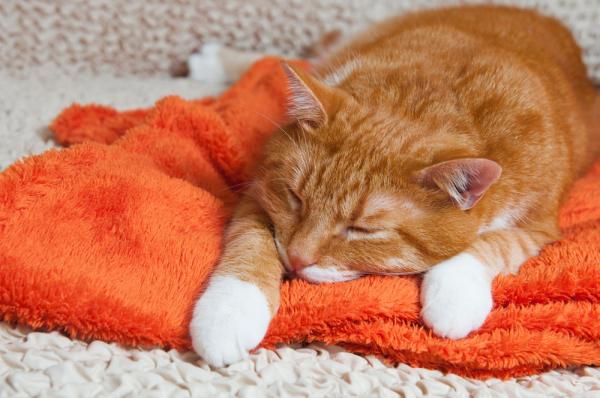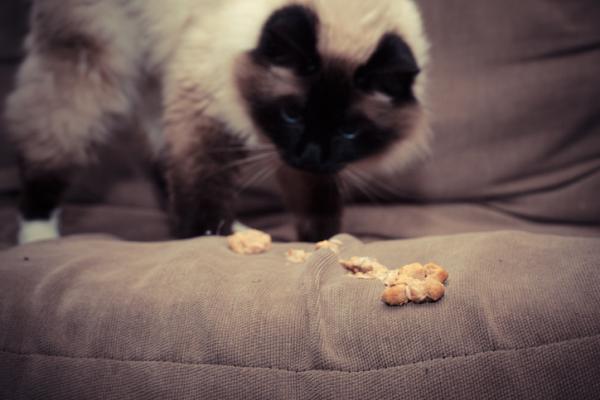Feline hepatic lipidosis – Causes, symptoms and recovery

In this article we are going to talk about the feline hepatic lipidosis, a serious illness that can affect our cat, especially if you have problems of overweight or suffer from another pathology such as diabetes.
We will see that the lipidosis can be primary or secondary, we will identify the symptoms that it produces and we will explain what its treatment consists of. Early diagnosis will quickly establish veterinary support and improve the prognosis of a disease that can be fatal.
What is feline hepatic lipidosis?
Feline hepatic lipidosis, also known as Feline fatty liver syndrome, consists precisely in the accumulation of fat in the liver and this can occur in a primary or secondary way, which we can characterize in the following way:
- Primary or idiopathic hepatic lipidosis: in these cases the accumulation occurs due to some failure in the metabolism of which the cause is unknown. It is known that obese cats that have a prolonged fasting period, such as one that can trigger stress, have a propensity.
- Secondary hepatic lipidosis: is the one that occurs in most cases. Cats with this type of lipidosis suffer from a disease that predisposes them to the accumulation of fat, that is, lipidosis will occur as a consequence of previous pathologies such as diabetes, infectious diseases, hypothyroidism, pancreatitis or inflammatory bowel disease. .
Symptoms of feline hepatic lipidosis
That our cat stop eating You should always put us on alert. In cases of lipidosis, in addition, the cat will lose weight and lose muscle mass. We can also observe vomiting, diarrhea, apathy, dehydration and symptoms derived from the involvement of the liver, such as jaundice, that is to say, the yellowish coloration that their mucous membranes can present.
Sometimes the malfunction of the liver, organ that fulfills important functions in the metabolism, causes toxic substances to accumulate that end up affecting the cat, provoking it neurological symptoms. These can end up in coma and death. In addition, if the lipidosis is secondary to another disease, the cat will present the symptoms that this causes.
It is important establish the diagnosis differentiating if we are facing a primary or secondary lipidosis, since, in the second case, we should also treat the initial disease. In general, in a blood test we will find elevated parameters related to liver function. At a palpation, it is possible to notice the increased liver.

Does feline hepatic lipidosis cure?
For treatment of lipidosis in catsIn addition to medicating the initial pathology if there is, feeding and hydration are basic. As we have said, the cat will refuse the food, which will aggravate the picture. Since we can not force the animal to eat, we recommend tube feeding, in different locations, you will have to place our veterinarian.
At first the cat will have to remain hospitalized, but it is recommended that he return home soon, since the stress that these animals usually feel in the clinic does not favor their recovery. If our cat has to take a probe at home, the veterinarian will explain its management. Later, we can start offering solid food, several times a day in small portions until it is restored. In this way, we see how feline hepatic lipidosis yes it has a cure, as long as it is diagnosed on time.
Recovery and prevention of feline hepatic lipidosis
It is true that lipidosis can cause the death of the cat, but with early treatment the chances of recovery are high. Cats that overcome the disease do not have to show sequelae or relapses. As prevention of lipidosis, in addition to check our cat at least once a year to detect early any disease that may lead to the accumulation of fat in the liver and treat it properly, we should seek always keep it at an appropriate weight, for which it is important that we offer a balanced diet tailored to your needs. Check the following article to know more about this point: “How to prevent obesity in cats.”
In addition, it is convenient to keep it in what is known as a enriched environment, with opportunities to exercise and sufficient activity, because stress is another factor involved in the appearance of hepatic lipidosis in cats. It is also advisable to avoid diets rich in fats or carbohydrates.

This article is merely informative, in .com we do not have the faculty to prescribe veterinary treatments or make any kind of diagnosis. We invite you to take your pet to the veterinarian in case of any type of condition or discomfort.
If you want to read more articles similar to Feline hepatic lipidosis – Causes, symptoms and recovery, we recommend that you enter in our section of Other health problems.


